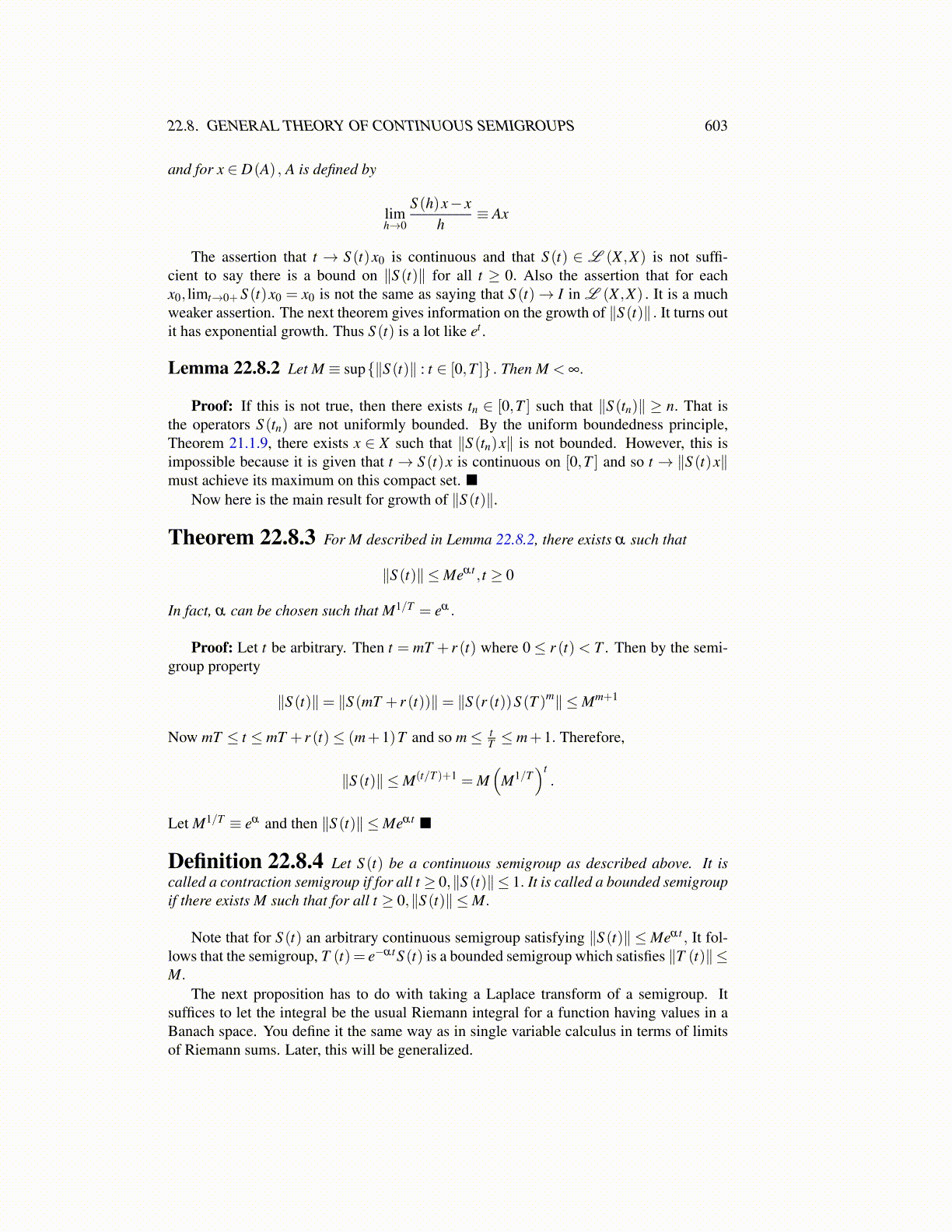
22.8. GENERAL THEORY OF CONTINUOUS SEMIGROUPS 603
and for x ∈ D(A) , A is defined by
limh→0
S (h)x− xh
≡ Ax
The assertion that t → S (t)x0 is continuous and that S (t) ∈ L (X ,X) is not suffi-cient to say there is a bound on ∥S (t)∥ for all t ≥ 0. Also the assertion that for eachx0, limt→0+ S (t)x0 = x0 is not the same as saying that S (t)→ I in L (X ,X) . It is a muchweaker assertion. The next theorem gives information on the growth of ∥S (t)∥ . It turns outit has exponential growth. Thus S (t) is a lot like et .
Lemma 22.8.2 Let M ≡ sup{∥S (t)∥ : t ∈ [0,T ]} . Then M < ∞.
Proof: If this is not true, then there exists tn ∈ [0,T ] such that ∥S (tn)∥ ≥ n. That isthe operators S (tn) are not uniformly bounded. By the uniform boundedness principle,Theorem 21.1.9, there exists x ∈ X such that ∥S (tn)x∥ is not bounded. However, this isimpossible because it is given that t → S (t)x is continuous on [0,T ] and so t → ∥S (t)x∥must achieve its maximum on this compact set. ■
Now here is the main result for growth of ∥S (t)∥.
Theorem 22.8.3 For M described in Lemma 22.8.2, there exists α such that
∥S (t)∥ ≤Meαt , t ≥ 0
In fact, α can be chosen such that M1/T = eα .
Proof: Let t be arbitrary. Then t = mT + r (t) where 0 ≤ r (t) < T . Then by the semi-group property
∥S (t)∥= ∥S (mT + r (t))∥= ∥S (r (t))S (T )m∥ ≤Mm+1
Now mT ≤ t ≤ mT + r (t)≤ (m+1)T and so m≤ tT ≤ m+1. Therefore,
∥S (t)∥ ≤M(t/T )+1 = M(
M1/T)t.
Let M1/T ≡ eα and then ∥S (t)∥ ≤Meαt ■
Definition 22.8.4 Let S (t) be a continuous semigroup as described above. It iscalled a contraction semigroup if for all t ≥ 0,∥S (t)∥≤ 1. It is called a bounded semigroupif there exists M such that for all t ≥ 0,∥S (t)∥ ≤M.
Note that for S (t) an arbitrary continuous semigroup satisfying ∥S (t)∥ ≤Meαt , It fol-lows that the semigroup, T (t) = e−αtS (t) is a bounded semigroup which satisfies ∥T (t)∥≤M.
The next proposition has to do with taking a Laplace transform of a semigroup. Itsuffices to let the integral be the usual Riemann integral for a function having values in aBanach space. You define it the same way as in single variable calculus in terms of limitsof Riemann sums. Later, this will be generalized.